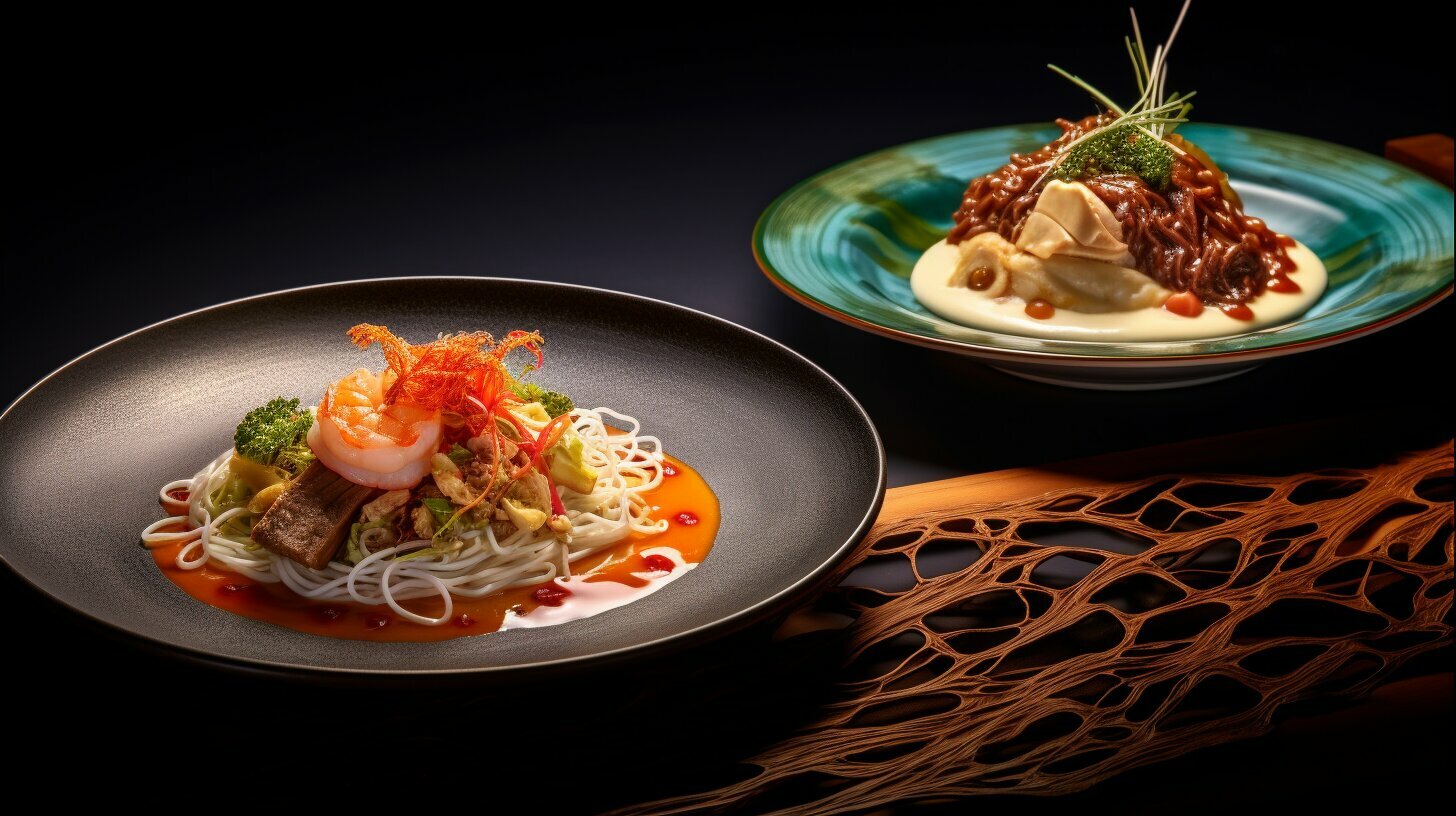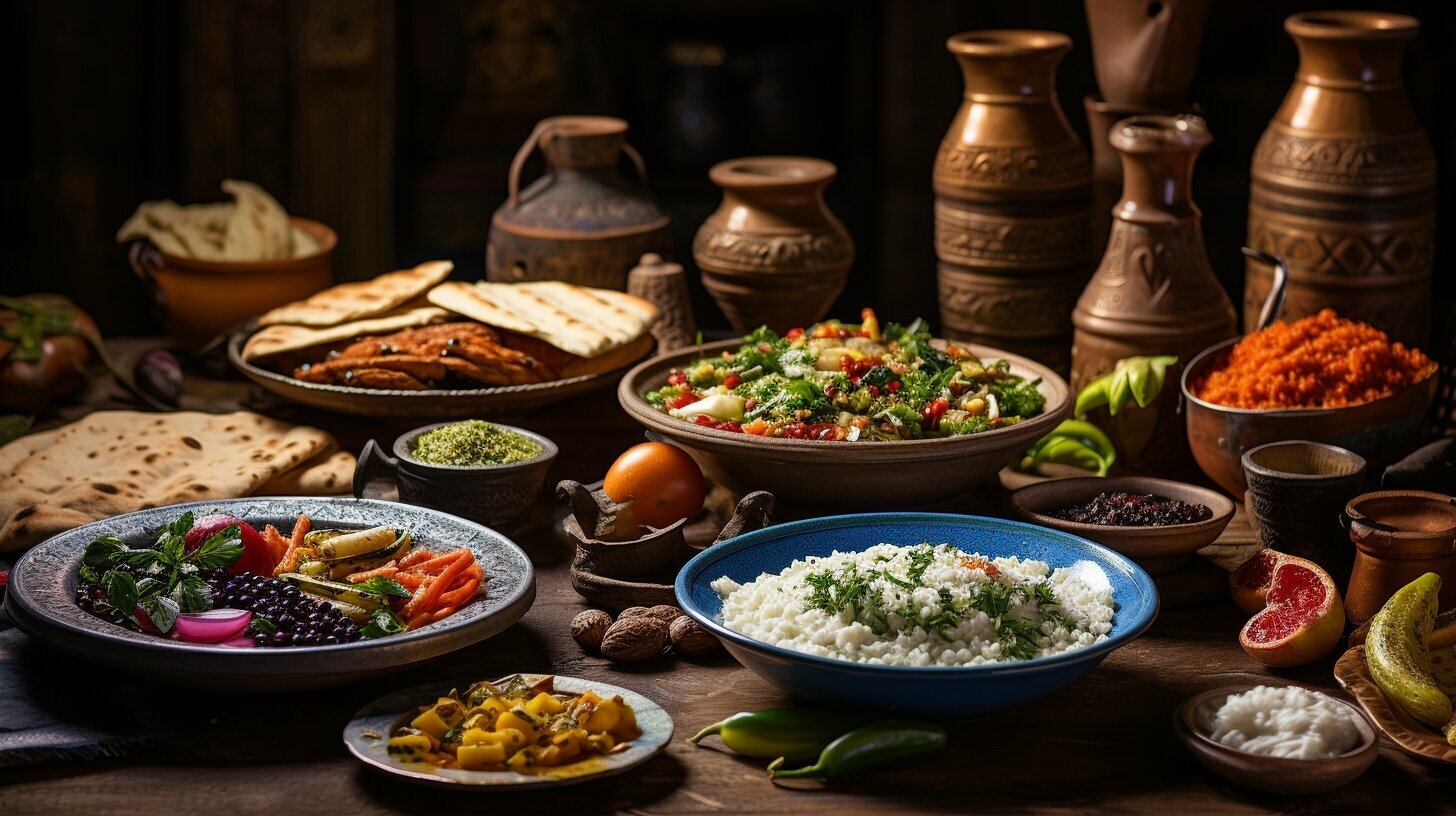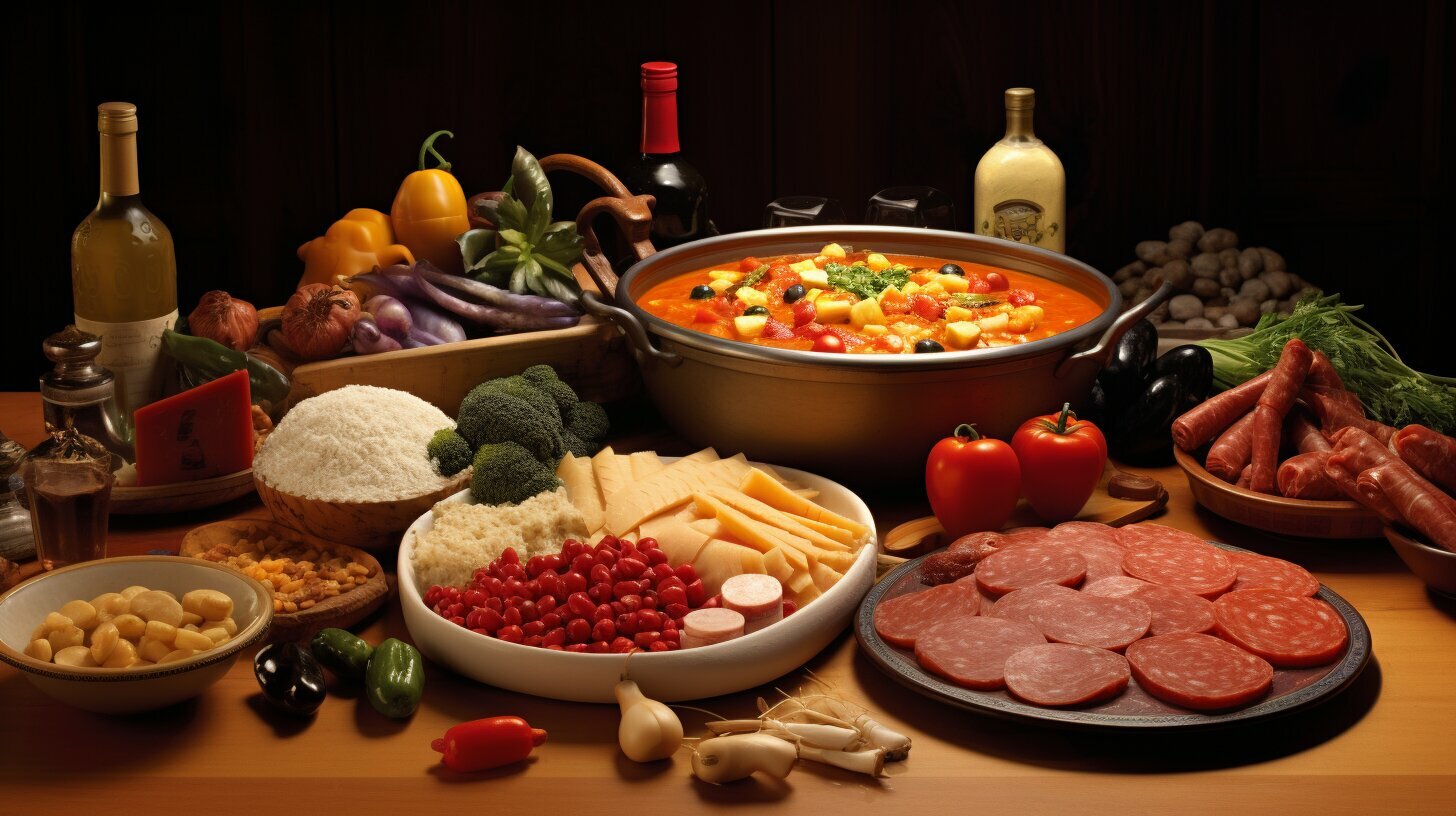Korean and Japanese cuisine are two of the most popular food cultures in the world, known for their unique recipes, ingredients, and techniques. Food holds tremendous cultural significance in both Korean and Japanese culture, where meals are often seen as a time for family bonding and socializing. While these cuisines share some similarities, there are also significant differences that make each one unique.
Key Takeaways:
- Korean and Japanese cuisines are known for their unique recipes, ingredients, and techniques.
- Both cultures place a great emphasis on the cultural significance of food.
- While there are similarities between Korean and Japanese cuisine, there are also significant differences that make each one unique.
- The following sections will explore the key differences between Korean and Japanese cuisine in more detail.
Key Differences in Flavor Profiles
Korean and Japanese cuisine showcase unique flavor profiles that distinguish them from one another.
Korean cuisine is known for its bold, spicy flavors achieved through the use of Korean spices like gochugaru (Korean chili flakes) and gochujang (spicy chili paste). Fermented cabbage (kimchi) is also a staple ingredient that adds a sour and spicy kick to many Korean dishes.
On the other hand, Japanese cuisine tends to have a more subtle and delicate flavor profile, with a focus on umami flavors derived from ingredients like soy sauce, miso, and dashi. Japanese spices like shichimi togarashi (seven spice powder) and yuzu kosho (citrus and chili paste) also contribute to the unique flavors found in Japanese cuisine.
Key Differences in Flavor Profiles
| Korean Cuisine | Japanese Cuisine |
|---|---|
| Bold, spicy flavors | Subtle, delicate flavors |
| Use of Korean spices like gochugaru and gochujang | Focus on umami flavors from soy sauce, miso, and dashi |
| Presence of fermented cabbage (kimchi) | Use of Japanese spices like shichimi togarashi and yuzu kosho |
In summary, Korean cuisine is characterized by bold and spicy flavors, while Japanese cuisine is more subtle and delicate. Both cuisines use unique spices that contribute to their distinct flavor profiles.
Unique Ingredients in Korean Cuisine
One of the defining features of Korean cuisine is its unique use of ingredients. From fermented soybean paste to fiery chili flakes, Korean dishes are rich in complex and bold flavors. Here are some of the most commonly used ingredients in Korean cuisine:
| Ingredient | Description |
|---|---|
| Doenjang | A fermented soybean paste that is similar to miso. It is a staple in Korean households and is often used in stews, soups, and marinades. |
| Gochugaru | Korean chili flakes that are typically used to add heat and depth of flavor to dishes like kimchi, bulgogi, and bibimbap. |
| Sesame oil | A fragrant and nutty oil that is used as a finishing oil in many Korean dishes. It adds richness and depth of flavor. |
Another common ingredient in Korean cuisine is gochujang, a spicy and savory chili paste made from fermented soybeans, rice, and chili peppers. It is used as a condiment, marinade, and seasoning in many Korean dishes. Other popular ingredients include perilla leaves, anchovies, and mung bean sprouts.
The combination of these unique ingredients creates the distinct flavors and textures found in Korean cuisine. From savory and spicy to tangy and sweet, Korean dishes are a true culinary delight.
Unique Ingredients in Japanese Cuisine
Japanese cuisine is renowned for its use of unique and flavor-packed ingredients that add depth and complexity to dishes.
Mirin: This sweet rice wine is a key ingredient in many Japanese sauces and marinades, adding a distinctive sweetness and depth of flavor.
Bonito flakes: These dried, shaved flakes of fermented tuna are used to make dashi, a flavorful broth that serves as a base for many Japanese soups and sauces.
Nori: A type of seaweed, nori is often used to wrap sushi rolls or as a garnish for soups and noodle dishes, adding a savory and slightly nutty flavor.
Miso: Made from fermented soybeans, miso is a versatile ingredient that is used in everything from soups to marinades to dressings, adding a rich umami flavor.
Soy sauce: A staple in Japanese cuisine, soy sauce is made from a combination of soybeans, wheat, salt, and water, and is used to flavor everything from stir-fries to sushi.
Unique Ingredients in Japanese Cuisine
While these ingredients are all essential to the authentic flavors of Japanese dishes, they are just a few examples of the many unique and delicious ingredients found in this cuisine.
Cooking Techniques: Contrasting Approaches
Korean and Japanese cuisine each have their unique cooking techniques that contribute to their distinct flavors and textures.
Korean cuisine often involves grilling, broiling, and stir-frying, resulting in dishes with bold and caramelized flavors. The use of sauces and marinades is also common in Korean cooking, adding complexity and depth to the dishes. In contrast, Japanese cuisine typically employs techniques like steaming, simmering, and raw preparations (sashimi), focusing on preserving the natural flavors of the ingredients. Seasonings and sauces are used sparingly, allowing the ingredients to shine.
These different approaches to cooking showcase the diverse culinary traditions of Korea and Japan. Whether you prefer the bold and savory flavors of Korean dishes or the delicate and nuanced flavors of Japanese cuisine, there is something for everyone to enjoy.
Popular Dishes in Korean Cuisine
Korean cuisine is known for its bold flavors, unique ingredients, and colorful presentation. Here are some popular dishes that you should definitely try:
- Bibimbap: A delicious bowl of rice topped with sautéed vegetables, beef, and a fried egg. This dish is often served with a side of spicy gochujang sauce.
- Bulgogi: Thinly sliced beef marinated in a sweet and savory sauce and grilled to perfection. Bulgogi is often served with lettuce leaves for wrapping and a side of rice.
Another popular dish is samgyeopsal, which is grilled pork belly often served with lettuce leaves, garlic, and ssamjang (spicy dipping sauce).
If you’re feeling adventurous, try kimchi jjigae, a spicy stew made with fermented cabbage, tofu, and pork. For a quick snack, grab some tteokbokki, which are spicy rice cakes served in a savory sauce.
Popular Dishes in Japanese Cuisine
Japanese cuisine is known for its delicate and nuanced flavors, achieved through the use of fresh and high-quality ingredients, as well as precise cooking techniques. Below are some popular dishes in Japanese cuisine that are sure to delight your taste buds.
Sushi
Sushi is perhaps the most recognizable Japanese dish, with its artful presentation and delicate flavors. Sushi is made with vinegared rice, often topped with fresh seafood, vegetables, or egg. The combinations are endless, making sushi a favorite for many.
Ramen
Ramen is a Japanese noodle soup dish that has become popular all over the world. Ramen consists of wheat noodles served in a savory broth, topped with meat (usually pork), egg, and vegetables. Ramen comes in many variations, from hearty miso to light and refreshing shio (salt) ramen.
Tempura
Tempura is a dish of lightly battered and deep-fried seafood or vegetables. The batter is made with flour, water, and sometimes egg, resulting in a deliciously crispy texture. Tempura is typically served with a dipping sauce and grated daikon radish, making for a flavorful and satisfying dish.
Sashimi
Sashimi is a dish of raw fish or seafood, thinly sliced and served with a variety of accompaniments, such as wasabi, soy sauce, and pickled ginger. The freshness and quality of the ingredients are of utmost importance in sashimi, resulting in a dish that is both simple and exquisite.
Udon
Udon is a thick and chewy Japanese noodle dish that is often served in a hot soup with various toppings like tempura, tofu and vegetables. It is made of wheat flour, salt and water and it pairs well with all sorts of broths and dipping sauces.
Exploring the Difference Between Korean and Japanese Cuisine: A Culinary Journey
As we conclude our culinary journey through Korean and Japanese cuisine, it’s clear that both have their unique flavors, ingredients, and cooking techniques. Korean cuisine is known for its bold and spicy flavors, utilizing ingredients like gochujang and kimchi. While Japanese cuisine tends to be subtle and delicate, relying on ingredients like soy sauce, miso, and dashi.
Additionally, Korean and Japanese cuisine differ in their cooking techniques. Korean cuisine often involves grilling, broiling, and stir-frying, while Japanese cuisine employs steaming, simmering, and raw preparations.
Some popular Korean dishes include bibimbap, bulgogi, and samgyeopsal, while Japanese cuisine is known for sushi, ramen, and tempura. These dishes showcase the unique flavors and ingredients of each cuisine.
Exploring the Difference Between Korean and Japanese Cuisine: A Culinary Journey
To summarize, exploring the difference between Korean and Japanese cuisine has been a delightful experience. Both cuisines offer unique flavors, ingredients, and cooking techniques that should be appreciated. Whether you prefer bold and spicy or subtle and delicate, both Korean and Japanese cuisine have something delicious to offer.
So, take a culinary journey of your own and try some Korean and Japanese dishes. You won’t be disappointed!
Keywords: Difference Between Korean and Japanese Cuisine
FAQ
Q: What is Korean cuisine known for?
A: Korean cuisine is known for its bold and spicy flavors, often achieved through the use of ingredients like gochujang (spicy chili paste) and kimchi (fermented cabbage).
Q: What are some unique ingredients in Korean cuisine?
A: Some unique ingredients commonly used in Korean cuisine include doenjang (fermented soybean paste), gochugaru (Korean chili flakes), and sesame oil.
Q: How does Japanese cuisine differ from Korean cuisine?
A: Japanese cuisine tends to be more subtle and delicate in flavor compared to Korean cuisine. It often focuses on umami flavors derived from ingredients like soy sauce, miso, and dashi.
Q: What are some popular dishes in Korean cuisine?
A: Some popular dishes in Korean cuisine include bibimbap (mixed rice bowl), bulgogi (marinated grilled beef), and samgyeopsal (grilled pork belly).
Q: What are some unique ingredients in Japanese cuisine?
A: Unique ingredients used in Japanese cuisine include mirin (sweet rice wine), bonito flakes, and nori (seaweed).
Q: What cooking techniques are commonly used in Korean cuisine?
A: Korean cuisine often involves grilling, broiling, and stir-frying, resulting in dishes with bold and caramelized flavors.
Q: What cooking techniques are commonly used in Japanese cuisine?
A: Japanese cuisine typically employs techniques like steaming, simmering, and raw preparations (sashimi), focusing on preserving the natural flavors of the ingredients.
Q: What are some popular dishes in Japanese cuisine?
A: Some popular dishes in Japanese cuisine include sushi, ramen, and tempura.
Q: What are the key differences between Korean and Japanese cuisine?
A: The key differences between Korean and Japanese cuisine include flavor profiles, ingredients used, and cooking techniques employed. Korean cuisine is known for its bold and spicy flavors, while Japanese cuisine tends to be more subtle and delicate. Korean cuisine uses unique ingredients like gochujang and kimchi, while Japanese cuisine incorporates ingredients like mirin and nori. Additionally, Korean cuisine often involves grilling and stir-frying, while Japanese cuisine focuses on steaming and simmering.
 Skip to main content
Skip to main content


